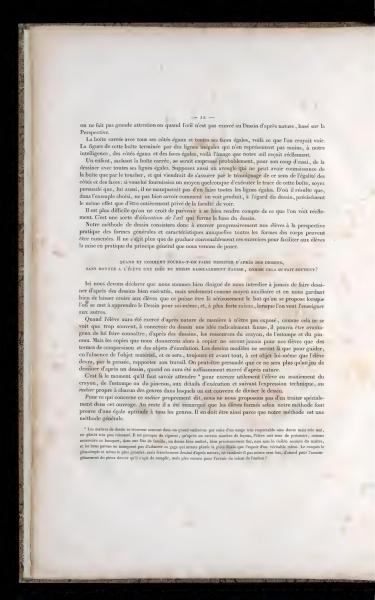Page 12
No great attention is given when the eye is not trained in life drawing based on Perspective.
The square box with all its equal sides and equal faces is what we thought we saw. The image of this box, finished with unequal lines, which nevertheless represent to our understanding equal sides and equal faces, is the image that our eye truly receives. A child, knowing the box is square, would probably hasten to draw it with all its lines equal. Suppose also a blind person who cannot know the box except by touch, and who comes to confirm by the testimony of this sense the equality of the sides and faces: if you provide him with some means to execute the outline of this box, be assured that he too would make all the lines equal. Thus, not knowing well how one sees produces about drawing the same effect as being entirely deprived of the faculty of seeing.
It is more difficult than one thinks to understand what one truly sees. It is a sort of education of the eye that forms the basis of drawing.
Our drawing method will therefore consist of progressively training our students in the practical perspective of general and characteristic forms to which all forms of bodies can be reduced. It is only necessary to properly graduate these exercises to facilitate students putting into practice the general principle we have just established.
When and how can one get students to draw from drawings without giving them a radically false idea of drawing, as often happens?
Here we must declare that we are far from intending to forever prevent drawing from well-executed drawings, but only as an auxiliary means and keeping students from believing that this can seriously be the aim when one sets out to learn drawing for oneself, and even more so, when one wants to teach it to others.
When the student has been exercised sufficiently from nature to be exposed, as is too often seen, to conceive a radically false idea of drawing, it will be advantageous to acquaint them with the resources of the pencil, the stump, and the brush from drawings. But when we give them something to copy, it will never be anything but terms of comparison and desire for emulation. The model drawings will only be there to guide, in the absence of the material object, and it will always above all be to this object itself that the student must mentally refer their work. One can be convinced that it will then be just as easy to draw from a drawing as from nature.
It is at this moment that one must know how to wait "to usefully train the student in the handling of the pencil, the stump, or the brush, in the details of execution and following the technical expression, in each of the genres in which drawing is agreed to be diversified.
As for the trade itself, we are not going to deal specifically with it in this work. However, it has been noted that students trained according to our method show equally good aptitude in all genres. It must be so because our method is a general method.
* Drawing teachers often find themselves in a great dilemma due to a very respectable but very poorly reasoned practice. It is almost mandatory that, after a certain number of lessons, the student is asked to produce, as an accessory to the bouquet in a family celebration, a well-shaded drawing, well embedded with the precise visible help of nature, and good parents do not fail to admire what attests more to a faithful piece than the hope of true talent. The simplest and even coarsest sketch, but frankly drawn from nature, would be more valuable this time, first for fulfilling the pious duty concerned, but even more so for the future of the child's talent?*
Translation Notes
Perspective: Here the term is used to refer to the technique in art used to represent three-dimensional objects on a two-dimensional surface.
Theory of education of the eye: This refers to training the visual perception to improve artistic skills.
Drawing effectively relies on training the eye to see real proportions and perspectives, rather than assumptions. Students are first trained in drawing from nature, and then from well-executed drawings to aid in understanding techniques and tools. This approach ensures students develop well-rounded skills in different artistic styles, as supported by a general method.
